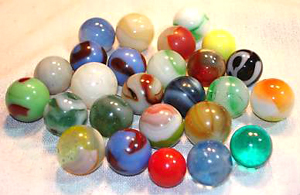In 1952-53 while in Mrs. Alf Taylor’s fourth grade class at Henry Johnson School, I was introduced to the game of marbles, soon becoming an avid devotee of the sport.
The instant our teacher escorted us to the east side playground for recess, several of us boys immediately began organizing a marble game. I cannot recall ever seeing girls engage in the competition; it was definitely a boy’s amusement. The first thing we did was to choose classmates with whom we wanted to play. I seem to recall that two to four people made an ideal match.
The site of the contest had to be carefully selected. It needed to be free of grass, weeds, rocks, clumps of dirt and debris. Most of our games were held in the clay dirt along the east backside of the playground next to the Fox residence. Once having found an ideal spot, we played on it repeatedly. On rare occasions, we used the sidewalk, but a paved surface was rough on the knees compared to softer ground. Besides, playing in the dirt was more fun for us tough guys.

After we selected our players and located a spot, it was time to get down to serious business. Using a stick, we first drew a one to two foot diameter circle in the dirt. Marbles varied in color from the bland to the very beautiful “catis eye” (referred to as “cat’s eyes”) that were made of clear glass with a swirl of color inside. We each put an agreed upon number in the ring, after which they became common property.
We took turns shooting a special marble, appropriately called a “shooter” or “taw, from anywhere outside the large circle, trying to knock one or more marbles out of it. We always had a couple of special “shooters” that we would not part with at any price.
Shooting a marble required the use of your thumb, index finger and middle finger. The middle and index fingers held the thumb and marble in place together in a cocked position until the player was ready to propel the marble forward. The shooting hand had to touch the ground while shooting; failure to do so resulted in an infraction called “fudging,” resulting in the individual losing his turn.
Whenever a marble exited the ring, it became that player’s possession. If you knocked a marble out of the ring and the shooter stayed inside the circle, you continued shooting from where it landed. Driving two or more marbles out of the ring with one attempt was called “dubs.” Anytime your shooter exited the circle, your turn was over. The game ended when all marbles had been cast out of the ring.
There were two varieties of the sport. One was “funsies” (playing for fun), where every participant went away with the same number of marbles that he had when he began. The other was “keepsies” (playing for keeps) that allowed you to keep all the marbles you shot out of the ring. The latter option was later considered by many schools to be a form of gambling and, consequently, not permitted.
I stored my marbles at home in an old Easter basket. When I took them to school, I carried them in an old sock. A status symbol on the playground was for us boys to parade around with marbles bulging from our pockets, indicating we were big game winners. This self-directed recognition was all we ever received for our efforts.
My marble playing days rolled away after I began attending Junior High School in the mid 1950s. Regrettably, I parted with my basket full of marbles by hitting each one with a wooden baseball bat, spraying them into a vacant lot adjacent to our Baxter Street residence. My pleasurable sport of yesteryear became passé.

Comments are closed.